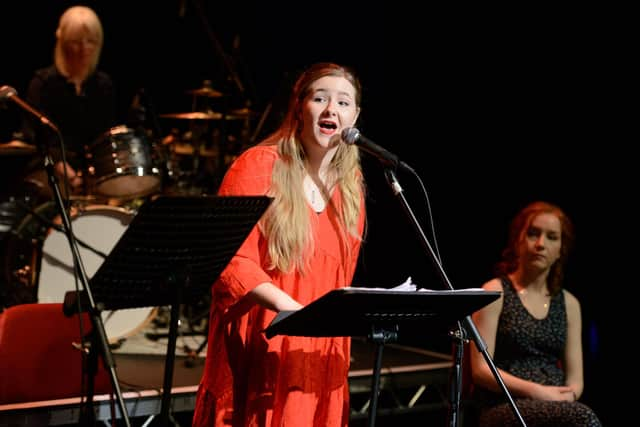A Mother's Song: The folk musical connecting the past with the present
Most of us have little sense of family history beyond our grandparents. Go a few generations back and things get vague. But one way the past continues to talk to the present is through culture. Songs, stories and poems are handed down from one age to the next, finding new resonances as they go. The words you sing in a folk song might once have been in the mouth of some distant ancestor.
This tradition is one of the ideas underpinning A Mother's Song, a new musical that skips across 400 years of history as it journeys from Scotland to Ulster to West Virginia. "I was interested in the idea of the migration of song," says composer Finn Anderson. "As a song travels, it changes and evolves. Scottish folk songs and ballads journeyed to Appalachia and in this mountain range, they are still alive in their original form. There are Scottish songs there that don't even exist in Scotland any more."
Advertisement
Hide AdThe show is a joint enterprise between Anderson, co-creator of the acclaimed Islander, and director Tania Azevedo, currently resident director on & Juliet in the West End. It is about a woman beginning a new life in modern-day Brooklyn who, as she considers the possibility of motherhood, feels the urge to connect with her estranged family. Somewhere along the way, she has broken the link to a long line of ballad singers who left 17th century Stirling for 18th century Ulster and then headed west to the United States.


"A song carries not only a story but also an emotional charge," says Azevedo. "It brings emotional stories from your ancestors, who are people we have no concept of. In this case, someone learns about the story of her great-great-great ancestors and the struggles they have gone through."
Chief among those struggles is childbirth. In today's New York, Sarah sets up home with her female partner and thinks about parenthood. In the Scotland of 1609, Cait tries for a baby, as is expected of the wife of a minister. And in the Ulster of the 1700s, the teenage Jean finds herself pregnant after a fling with a sailor. It is only in today's story that motherhood is a choice not an inevitability.
"I was interested in a musical that explored women's autonomy over their own bodies," says Azevedo. "I was also interested in the way the concepts of womanhood and motherhood have often been linked through history."
As befits such a female-centric narrative, the production at Stirling's Macrobert Arts Centre puts women centre stage. The all-female live band – comprising what Anderson calls "some of Scotland's best musicians" – accompanies half a dozen actors, only one of them male. "To me it feels different and new," says Azevedo. "And it feels important for the story."
Anderson adds: "With the passing down of these songs, it is so often the women who keep that oral tradition going. The tradition of singing a song connects you to the past and the future all at once."
Advertisement
Hide AdIn a show that is 80 per cent music, the composer puts a 21st-century stamp on traditional airs, leaning into the folk tradition without creating a pastiche. As the songs are passed down through the generations, a tune of lament for one woman becomes a lullaby for the next.
"The score is mostly original music but there are also traditional ballads," he says. "We hear them in bluegrass style as they're sung in Appalachia today and we get to hear their evolution. The original music embraces the spectrum to give a contemporary version of the traditional Scottish sound as well as drawing on pop, country and Americana. The whole point of the traditions is that they need to stay alive."
Advertisement
Hide AdAzevedo adds: "A big theme of the show is marrying one's contemporary identity with one's heritage and how you may use the past to move forward."
As is the way of musicals, A Mother's Song has been a long time coming. It started life five years ago as a commission from the Royal Conservatoire of Scotland and the American Music Theatre Project, the brief being to create an hour-long show for a large transatlantic cast. Now it resurfaces as a two-act show, with its narratives more tightly focused and twice as many songs.
As a director, Azevedo finds herself in a privileged position. She is used to working on other people's ideas, but in the case of A Mother's Song, she and Anderson have developed the show together from the start. It has given her an unusually close attachment to A Mother's Song.
"There is no scene that I have to 'make work' because we know why every scene is there," she says. "It's the easiest thing I've ever had to direct because I know it. It brings a different dynamic to the rehearsal room."
The feeling is mutual. "As a writer of musical theatre, I can't stress enough how valuable it is to have a collaborator who cares about and loves musicals as much as I do," says Anderson. "Tania is so experienced in her understanding of how musicals work – how they're different to plays and to gig theatre; how characters expressing themselves through song is a real thing that needs to be worked through; how the whole rhythm of the show feels. In Scotland, there are not loads of people who have their teeth into it as she does."
A Mother’s Song: A New Folk Musical, Macrobert Arts Centre, Stirling, 23-26 February.